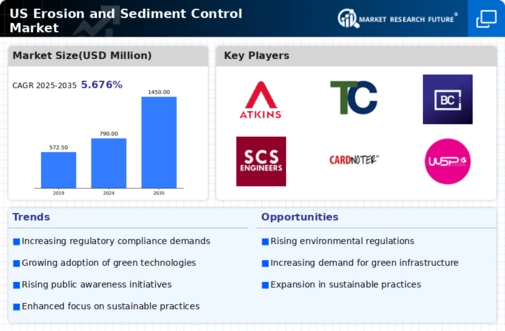Climate Change Impacts
The effects of climate change are increasingly recognized as a significant driver of the erosion and-sediment-control market. With rising temperatures and changing precipitation patterns, the frequency and intensity of storms are likely to increase, leading to heightened soil erosion and sediment runoff. The National Oceanic and Atmospheric Administration (NOAA) has reported that extreme weather events are becoming more common, which poses challenges for land management. As a result, there is a growing need for effective erosion control solutions to protect vulnerable landscapes. This trend suggests that the erosion and-sediment-control market may see a surge in demand for adaptive strategies that can withstand the impacts of climate change.
Growing Environmental Awareness
There is a notable increase in environmental awareness among the public and policymakers, which significantly impacts the erosion and-sediment-control market. As communities become more conscious of the effects of soil erosion on ecosystems and water quality, there is a push for sustainable land management practices. This shift in public sentiment has led to the introduction of various state and federal initiatives aimed at promoting erosion control measures. For instance, the Environmental Protection Agency (EPA) has implemented programs that encourage the adoption of best management practices (BMPs) for erosion control. This heightened awareness is expected to drive demand for innovative solutions in the erosion and-sediment-control market, as stakeholders seek to align with environmental goals.
Regulatory Compliance and Standards
The erosion and-sediment-control market is significantly influenced by regulatory compliance and standards set forth by governmental agencies. The Clean Water Act and various state regulations mandate that construction and land development projects implement erosion control measures to prevent sedimentation in waterways. Non-compliance can result in substantial fines and project delays, prompting companies to invest in effective erosion control solutions. The market is expected to grow as businesses increasingly prioritize compliance with these regulations. In 2025, it is estimated that the costs associated with non-compliance could reach upwards of $500 million, further incentivizing investment in the erosion and-sediment-control market.
Increased Infrastructure Development
The ongoing expansion of infrastructure in the United States is a primary driver for the erosion and-sediment-control market. As urbanization accelerates, the demand for effective erosion control measures becomes critical to mitigate soil loss and sedimentation in waterways. According to the U.S. Census Bureau, construction spending reached approximately $1.5 trillion in 2025, highlighting the scale of infrastructure projects. These projects often require compliance with environmental regulations, which necessitate the implementation of erosion and sediment control practices. Consequently, the erosion and sediment control market is likely to experience growth. as construction companies seek to adhere to these regulations while maintaining project timelines and budgets.
Technological Innovations in Erosion Control
Technological advancements in erosion control methods are transforming the erosion and-sediment-control market. Innovations such as biodegradable erosion control blankets, advanced sediment filtration systems, and real-time monitoring technologies are becoming more prevalent. These technologies not only enhance the effectiveness of erosion control measures but also improve compliance with regulatory standards. The market for erosion control products is projected to grow at a CAGR of approximately 6% from 2025 to 2030, driven by these innovations. As companies seek to implement more efficient and sustainable solutions, the erosion and-sediment-control market is likely to benefit from the integration of cutting-edge technologies.




















Leave a Comment